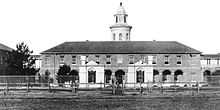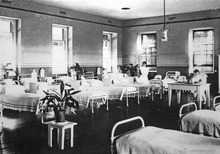Liverpool Hospital
| Liverpool Hospital | |
|---|---|
| South Western Sydney Local Health District | |
| Geography | |
| Location | Liverpool, New South Wales, Sydney, New South Wales, Australia |
| Coordinates | 33°55′11″S 150°55′49″E / 33.91972°S 150.93028°ECoordinates: 33°55′11″S 150°55′49″E / 33.91972°S 150.93028°E |
| Organisation | |
| Care system | Medicare (Public) |
| Hospital type | Teaching |
| Affiliated university | University of Western Sydney |
| Services | |
| Emergency department | Yes |
| Beds | 855 |
| History | |
| Founded | 1813 |
| Links | |
| Website | http://www.swslhd.nsw.gov.au/liverpool/ |
| Lists | Hospitals in Australia |
Liverpool Hospital is located in the south-western suburbs of Liverpool, New South Wales and is 50 minutes away from the Sydney CBD. It is the largest hospital in New South Wales and one of the leading trauma centres in Australia.
It has a maximum capacity of 855 beds, 23 operating rooms and 60 critical care beds, diagnostic and imaging services, emergency and trauma care, maternity, paediatric, cancer care, mental health, ambulatory care, allied health and medical and surgical services from birth to aged care.
The Hospital is the major health service for south-western Sydney, providing services to the local government area of Liverpool City Council as well as district services to residents and visitors in the area. It also provides a range of statewide services in areas such as critical care and trauma, neonatal intensive care and brain injury rehabilitation.
Liverpool Hospital sits within an education and health precinct which includes the Ingham Institute of Applied Medical Research, Clinical Schools of the University of New South Wales and University of Western Sydney, South West Private Hospital and South Western Sydney TAFE.
It is a principal teaching hospital of the University of New South Wales and the University of Western Sydney and continues to have an active education programme for medical practitioners, nurses and health professionals, with a range of clinical placements available for students from universities around Australia.
200 year anniversary

In 2013, Liverpool Hospital celebrated two centuries of caring for the community. Liverpool Hospital’s first brick building was commissioned 200 years ago in 1813 on a portion of land beside the Georges River. It was originally run as a tent hospital for soldiers and convicts in the early 1790s, making it the second oldest hospital in Australia.
As part of the celebrations, the Hospital launched a 200th Anniversary website with historical images, a history of the hospital and information about upcoming events. Other activities throughout the year include the opening of a Hospital museum, photographic wall display, community open day and bicentenary book which allow Hospital staff and community to reflect on the achievements of the Hospital over the course of its history.
History

A new settlement
Governor Macquarie founded the township of Liverpool on 7 November 1810 to meet the needs of a spreading settlement. Having likely started as a tent hospital in the 1790s, Liverpool Hospital was established in a brick building on the banks of the Georges River in 1813, where it was run as a hospital for soldiers and convicts.
The Hospital had three rooms and could house up to 12 patients, who received rations of one pound of meat and one pound of wheat or flour a day. Medicine in the early half of the 1800s was quite limited, with most Hospital treatments consisting of blood-letting by cupping or leeching, entices for the stomach and purgatives. Instruments for operations were carried in the surgeon's pocket or top hat, although they would have mostly dealt with medical emergencies such as epidemics, accidents and snake bites. Construction of Liverpool Asylum, originally designed by Francis Greenway, commenced in 1822. Due to a decrease in population size, it was closed down in 1848 until 1851, when it reopened as The Liverpool Benevolent Asylum to provide shelter to aged, infirm and destitute men.
Liverpool Benevolent Asylum
The Asylum was commonly referred to as 'the yard', with inmates expected to assist in the upkeep of the institution. They were an extraordinarily diverse assortment of characters from all parts of the world and every rank, religion and occupation. There were ex-soldiers, seamen, miners, explorers, authors, businessmen and professional men. The majority were ordinary honest men, forced into hardship because of sickness, drink, destitution, old age, loneliness or lack of family support.
Liverpool District Hospital
From the late 1920s to 1935, the Liverpool State Hospital underwent a period of considerable improvement, expansion and development, despite the onset of the Great Depression. 1929 was the worst year of the Depression for the Asylum, with 2,567 admissions recorded. The number of inmates in residence in July that year reached a peak of 893, no doubt associated with the mid-winter weather.
In 1933 major works were undertaken to the hospital, including a modern operating theatre, outpatients department, women's ward, medical superintendent's residence and a morgue. These developments transformed the Hospital into a modern hospital with the facilities to undertake a wide variety of operations.
Liverpool State Hospital closed in 1958, ending 107 years of service to aged, sick and destitute men from all parts of the world. All acute cases were transferred to the newly constructed Liverpool District Hospital which had been built adjacent to the old State Hospital.
A booming population
By May 1966, Liverpool had become the fifth largest district hospital in the metropolitan area. Each year 70,000 patients were being treated, severely taxing the capacity of the 222-bed hospital.
When the new intensive and coronary care unit was equipped in late 1970, it was said to be one of the most advanced in the world. In May 1972, a world first orthopaedic operation was performed at Liverpool Hospital. It was a new technique for repositioning and internal fixation of bones which enabled the patient to walk. The operation was recorded on colour television for the first time in Australia by special arrangement with the equipment suppliers.
In 1974, the Don Everett Building, comprising 64 acute medical beds and a 40-bed psychiatric unit with an associated day care centre was built. In addition, a laminar flow theatre for orthopaedic surgery was installed - an Australian first. It had been developed by the American National Aeronautical and Space Administration (NASA) to filter and replace air in the theatre, sweeping away bacteria and reducing the risk of infection during orthopaedic surgery.
The word District was dropped from the name of the Liverpool Hospital in 1978, in recognition of its growing role in providing specialty services to the whole of south-western Sydney.
Liverpool Hospital became the principal teaching hospital of the University of New South Wales in 1989 and the University of Western Sydney in 2011. It continues to have an active education programme for medical practitioners, nurses and health professionals, with a range of clinical placements available for students from universities around Australia.[1]
Hospital expansion
Due to an increasing focus on education and the increasing population of south-western Sydney, a major expansion took place which was split into two stages of development.
Stage 1
Original development of Liverpool Hospital took place over the following years:
- 1992 - Health Services Building (Outpatient, Community Health and Academic Services)
- 1993 - Pathology (SWAPS) Building
- 1994 - Caroline Chisholm Centre for Women and Babies
- 1995 - Cancer Therapy Centre and Brain Injury Unit
- 1996 - The Thomas and Rachel Moore Education Centre
- 1997 - Clinical Building
Stage 2
The redevelopment has now been completed, consisting of the following works:
- Development of a new Clinical Building
- Civil works including new roads and a multi-storey car park for staff
- Refurbishment and expansion of the Cancer Therapy Centre
- Cancer Therapy Research Bunker
- Expanded Childcare Centre
- Grounds and landscaping
- Refurbishment of the Thomas & Rachel Moore Education Centre
- Clinical Skills and Simulation Centre
- Ingham Institute for Applied Medical Research
References
- ↑ Raszewski, C. et al (2013). 'The History of Liverpool Hospital: From early settlement to 1993'. The Liverpool Historical Society, Liverpool City Library and Liverpool Health Service.